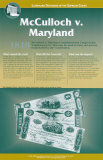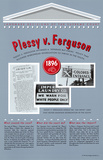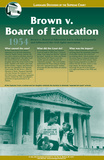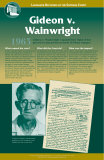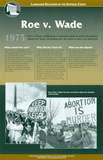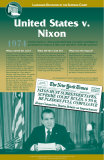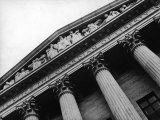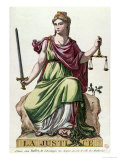|
|
|
|
|

Marbury v.
Madison
Poster
no longer available
|
Marbury v. Madison
established the Constitution as the supreme law of the land and affirmed the role of the Court. The Supreme Court's importance was firmly established under the direction of Chief Justice John Marshall.
2-24-1803
What caused the case? The case of Marbury v. Madison grew out of a conflict between the political parties. Just before Republican Thomas Jefferson became President in 1801, Federalist President John Adams chose a number of Federalist for government jobs – including William Marbury, who was chosen to be a justice of the peace. But Mr. Adams left office without sending Mr. Marbury his formal papers of appointment. President Jefferson then told Secretary of State James Madison not to deliver these papers. Under Section 13 of the Judiciary Act, Mr. Marbury sued for a "writ of mandamus" – an order forcing Mr. Madison to deliver the papers. Section 13 gave the Supreme Court the power to make this order.
What did the court do? - The Supreme Court did find that Mr. Marbury's appointment was wrongfully denied. But it refused to rule on the matter, and the case was dismissed. Chief Justice John Marshall, explained that Section 13 had wrongly given the Supreme Court powers not provided for in the Constitution. Therefore, he said Section 13 was "unconstitutional" – that is, it went against the Constitution – and could not be enforced.
What was the impact? Marbury v. Madsion may have been the Supreme Court's most important ruling. This ruling made it clear that the Constitution was superior to laws passed by Congress and state legislatures. And it made clear the Court's right to exercise "judicial review" – that is, its right to decide whether or not laws follow the Constitution. Today, the Court's most important work involves judicial review, in which it either overturns laws and other government acts or upholds them against challenge.
• background on Marbury v Madison
|
|
|
|
McCulloch v. Maryland
established that Congress has “implied powers” that may be used to carry out powers enumerated by the Constitution. The Supreme court ruled that federal bank notes could not be taxed by states.
3-6-1819
What caused the case? In 1816, the U.S. Congress created a national bank. A branch of the bank was set up Baltimore, Maryland. The bank made a charter for state banks as well. To protect its own state's banks, the Maryland legislature began to tax all notes issued by banks not created by the state. James McCulloch, a cashier at the bank of the United States, refused to pay the tax. When he was found guilty of breaking the law, Mr. McCulloch sued. He said the state law was unconstitutional.
What did the court do? - In McCulloch v Maryland the Supreme Court agreed with Mr. McCulloch. It found that the national bank was created under the Constitution's "necessary and proper" clause. This clause allows Congress to make the laws it needs to carry out its constitutional powers. In this case, a national bank was needed to enable Congress to regulate commerce and to coin and borrow money. The Court also ruled that the Maryland law was unconstitutional because the tax interfered with the operation of a federal bank.
What was the impact? McCulloch v. Maryland helped clarify and strengthen the powers of the federal government. In this case, the Court made it clear that the Constitution does give Congress more than just those powers it mentions specifically. It also gives Congress "implied powers" – powers that are unstated, but that are clearly needed to carry out the powers and duties in the Constitution. The ruling also strengthened the idea that when state and federal laws conflict, federal law must prevail.
FYI ~ Noted statesman, orator and lawyer Daniel Webster argued the case for McCulloch.
|
|
|
|
Plessy v. Ferguson
5-18-1896, affirmed a ‘separate but equal’ policy that allowed widespread segregation to thrive in the South. Pless v Ferguson upheld the “Jim Crow” laws that helped maintain segregation in the South.
What caused the case? The case of Plessy v. Ferguson arose when Homer Plessy, a black man, objected to a Louisiana state law requiring separate railroad cars for black and whites. Mr. Plessy was arrested when he refused a condutor's order to sit in the car for black passengers. In a trial, Mr. Plessy was found guilty of breaking the law. In response, he sued the judge in the case, a man named John Ferguson. His suit claimed that the Louisiana law went against the Constitution's 14th Amendment, which guarantees to all citizens the equal protection of the laws.
What did the court do? - The Supreme Court reviewed Mr. Plessy's claim that the Louisiana law violated the 14th Amendment's equal protection guarantee. But the Court upheld the law. It agreed that the 14th Amendment did guarantee all citizens equal protection. However, it said that separate facilities did not take away this protection – as long as the facilities were truly equal. Moreover, it denied that such "separate but equal" facilities would necessarily make black feel inferior to whites.
What was the impact? In Plessy v. Ferguson, the court said it would allow “separate but equal” public facilities for blacks and whites. And in the years that followed, many states did set up racially separate public facilities. But these facilities were seldom equal. In fact, accommodations for whites were almost always superior to those for blacks. In effect, the ruling made it easier for widespread segregation to exist throughout the South and elsewhere for more than 50 years.
• background on Plessy v Ferguson
• Civil Rights Posters
|
|
|
|
Brown v. Board of Education Topeka, Kansas
5-17-1954 - “Separate educational facilities are inherently unequal.”
What caused the case? In 1951, Karen Brown was denied admission to an all-white elementary school in Topeka, Kansas. Instead, she was told to attend an all-black school in another neighborhood. Her father sued the school district for not letting his daughter attend the school closest to her home. Together with similar cases from South Carolina, Virginia and Delaware, the case was appealed to the Supreme Court under the title, Brown v. Board of Education of Topeka. Thurgood Marshall, who later became the Supreme Court's first black Justice, argued fhat segregated schools violated the 14th Amendment's guarantee of equal protection to all citizens.
What did the court do? - In an unanimous decision, the Supreme Court set aside its 1896 Plessy v. Ferguson ruling. That ruling had allowed “separate but equal” facilities for whites and blacks. Chief Justice Earl Warren wrote that racially separate public schools are always wrong – no matter how “equal” in quality. The Court further undermined the Plessy ruling by finding that such “separate but equal” facilities do encourage the idea that blacks are inferior to whites.
What was the impact? Brown v. Board of Education of Topeka did not bring about the immediate integration of all public schools. But it did have far-reaching effects. School systems across the nation began to integrate blacks into what had been all-white schools. Many began busing programs in an effort to balance the mix of races. And to a very large degree, the decision helped encourage the growth of the historic civil rights movement of the 1950s and 1960s.
• background on Brown v Board of Education
|
|
|
|
Gideon v. Wainright
1963 - Gideon v. Wainwright expanded the right of due process to any person accused of felony charges.
What caused the case? In 1961 Clarence Gideon was arrested and accused of breaking into a poolroom in Florida. Mr. Gideon had no money. So when his trial began, he asked the judge to appoint a lawyer for him. The judge refused, claiming that the right to legal counsel listed in the 6th Amendment did not apply to state criminal charges. Mr. Gideon went to trial without the help of a lawyer. The jury found him guilty, and he was sentenced to five years in prison. While in prison, Mr. Gideon sent the handwritten petition shown here to the Supreme Court. This petition asked the court to review his case.
What did the Court do? The Supreme Court asked Abe Fortas, who would later become a justice on the Court, to plead Mr. Gideon's case. After hearing both sides, the Court decided that the state had been wrong not to appoint a lawyer for Mr. Gideon. It said Mr. Gideon had the right to a lawyer because of the 14th Amendment rule ordering states to protect each individual's right to “due process of law.” The Court ordered a new trial and a state-appointed lawyer for Mr. Gideon – and he was later found not guilty.
What was the Impact? Gideon v. Wainwright is significant because it extended the 14th Amendment's due process rule to all individuals accused of serious crimes – whether on federal or state charges. Before Gideon v. Wainwright, the Court had begun applying the 14th Amendment to state laws involving a few of the first ten amendments to the Constitution. This decision greatly expanded the power of the 14th Amendment to protect individuals rights against abuses by both federal and state officials.
• background on Gideon v Wainright
|
|
|
|
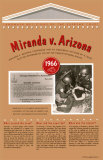
Miranda v Arizona
Poster
no longer available
|
Miranda v. Arizona
6-13-1966, the U.S. Supreme Court held that suspects, prior to being interrogated by police, must be informed of their rights under the Fifth and Sixth Amendments to the United States Constitution.
• background on Miranda v Arizona
|
|
|
|
Roe v. Wade
Reaffirmed a woman's right to make decisions about her body, including the decision to have an abortion. Since Roe v Wade, the issue of abortion rights has remained controversial. 1-22-1973
What caused the case? The case of Rov v. Wade began in 1970 when a woman named Norma McCorvey was denied an abortion in Texas. A law there made abortion a crime. Ms. McCorvey disagreed with the law, and met with lawyers to see what right she had in the matter. The lawyers agreed to work with her to change the law. Using the name Jane Roe to keep Ms. McCorvey's identity secret, they sued Dallas Count district Attorney Henry Wade.
What did the court do? In considering Roe v. Wade, the Supreme Court weighed the state's interest in protecting life against the individual's right to privacy. In a 7-2 decision, the Court struck down the Texas abortion law. It ruled that an unborn fetus is not legally a "person" and is therefore not protected by the Constitution. It als ruled that states may not interfere with a woman's decision to have an abortion during the first trimester, or three-month period, of a pregnancy. It allowed states to make rules for abortions performed in the second trimester. And it said states can ban all abortions in the last trimester, except those intended to save the mother's life.
What was the impact? Roe v. Wade was a far-reaching decision that affected abortion laws in 31 states. And it has remaind one of the most controversial decisions ever handed down. Proponents claim that it reaffirmed a woman's right to make decisions about her body. But opponents claim it failed to protect the lives of unborn children, who are unable to protect themselves.
• background on Roe v. Wade
• Margaret Sanger
|
|
|
|
United States v. Nixon
provided that executive privilege is permitted as long as it does not interfere with due process. By ruling against president Richard Nixon, the court played a role in his eventual resignation. 7-24-1974
What caused the case? On June 17, 1972, a burglary took place at the Democratic National Headquarters at the Watergate complex in Washington, D. C. The burglars were soon linked to President Richard Nixon's re-election committee. And in time, it became clear that top Nixon Administration officials were working to cover up the burglary. In April 1974, a special prosecutor ordered the release of tape recordings Mr. Nixon made of meeting with those officials. The special prosecutor believed the tapes would prove that Mr. Nixon was involved in the cover-up. Mr. Nixon refused to obey the order, claiming “executive privilege.” That is, he claimed that the executive branch of government has a right to withhold many kinds of evidence, even in a criminal case.
What did the court do? On July 24, 1974, the Court ruled against Mr. Nixon. In a unanimous opinion, it said executive privilege may not be used to withhold evidence in a criminal case. Mr. Nixon released the tapes, and they showed that he had taken part in a cover-up of the break-in. Fearing probable inpeachment, Mr. Nixon announced on August 8, 1974, that he would resign form the Presidency.
What was the impact? The impact of U.S. v Nixon was that it helped bring about a presidential resignation. It was also important in setting limits on executive privilege, and on any President's ability ot misuse the powers of that office. The opinion also strenthened public confidence in the Supreme Court. Though four of the Court's Justices had been appointed by Mr. Nixon himself, these Justices all joined the others in ruling to limit his powers.
• background on U.S. v Nixon
|
|
|
|
|
|
• “When Kansas and Colorado have a quarrel over the water in the Arkansas River they don’t call out the National Guard in each state and go to war over it. They bring a suit in the Supreme Court of the United States and abide by the decision. There isn’t a reason in the world why we cannot do that internationally.” ~ Harry S Truman
|
|
previous page | top
|
|
I have searched the web for visual, text, and manipulative curriculum support materials - teaching posters, art prints, maps, charts, calendars, books and educational toys featuring famous people, places and events - to help teachers optimize their valuable time and budget.
Browsing the subject areas at NetPosterWorks.com is a learning experience where educators can plan context rich environments while comparing prices, special discounts, framing options and shipping from educational resources.
Thank you for starting your search for inspirational, motivational, and educational posters and learning materials at NetPosterWorks.com. If you need help please contact us.
|
|
|









